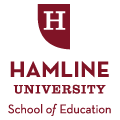Differentiation for student independence
Term
2006
Capstone
Thesis
Degree Name
MAEd
Abstract
My research study resulted from seeing special education students struggle with becoming independent in the classroom setting. Emphasis is placed on preparing secondary special education students for successful transition beyond high school. The more independently students can function in the school setting, it is more likely they will experience success after high school. By using a differentiated approach that isÊdesigned to fit students' learning preferences, interests and readiness levels students will be more likely to be engaged in their learning. Differentiation allows for more variety, flexibility and student choice in how students with different interests, learning styles and abilities can all learn the same key concepts in one classroom. My review of the literature provides evidence that differentiation can lead to developing independence in students. The literature about differentiated instruction includes research on the brain and how learning happens. Much of the literature reviewed corroborated the importance of designing instruction based on the needs of the learners. The literature emphasized many aspects of learning including the work of Howard Gardner and his theory of Multiple Intelligences, various learning style theories, and the use of interest inventories to help gain more knowledge of the students in your classroom. The purpose of my study was to determine how using differentiated instruction could help my students develop skills of independence. My study consisted of 4 secondary special education students in a special education math class who did not work very independently in any classroom setting. The students were initially assessed using a variety of assessment tools to determine readiness levels, interests and learning profile information. While all students were learning the same essential concepts in the unit, they were working on it in different ways, with different materials and demonstrating their learning in ways that matched their learning profile. Students were observed during class time, given opportunities for reflecting on the process and interviewed at the end of the unit. Also I kept a reflective journal of my observations and reactions to the events that took place. The results of the study were positive in that I did observe more student engagement in the activities. After a few weeks of working the differentiated classroom, 2 of the students began to initiate tasks on their own, which is one of the indicators of independence. Unfortunately, the time for the study was not long enough for me to see the results I had anticipated from the literature I reviewed. The key to differentiation according the experts is to start small, which is what I did. There were enough positive reactions from the students that I feel it is worth while to continue providing students with a differentiated approach to instruction in the classroom.
Recommended Citation
Greenwood, Jeanne L., "Differentiation for student independence" (2006). School of Education and Leadership Student Capstone Theses and Dissertations. 1772.
https://digitalcommons.hamline.edu/hse_all/1772

